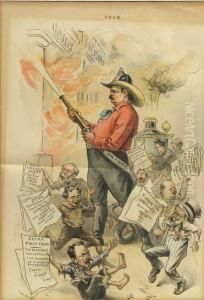William A. Rogers Paintings
William Allen Rogers was a prominent American illustrator and political cartoonist in the late 19th and early 20th centuries. Born on January 26, 1854, in Springfield, Ohio, Rogers developed an early interest in drawing, which would guide his career path. He did not receive extensive formal art training but showed remarkable natural talent from a young age. His career as an illustrator and cartoonist began in earnest when he started working for various newspapers and periodicals, leveraging his artistic skills to comment on social and political issues of his time.
Rogers is perhaps best known for his work with Harper's Weekly, a leading journal of the time, where he contributed from 1873 to 1893. His illustrations and cartoons for Harper's Weekly touched on various subjects, including the social upheavals, political scandals, and significant events of the era. He had a knack for capturing the essence of a moment or issue with humor and sharp insight, which made his work both popular and influential. Following his tenure at Harper's Weekly, Rogers worked for the New York Herald, further cementing his reputation as one of the foremost political cartoonists of his era.
Throughout his career, Rogers covered a wide range of topics, including the corruption of the Tammany Hall political machine, the Spanish-American War, and the policies of various U.S. presidents. His ability to distill complex issues into a single, impactful image made his work an important part of public discourse. Rogers was not just a commentator on his times; through his cartoons, he became an active participant in the political and social debates shaping America.
William A. Rogers continued to work and influence the world of political cartooning until his death on December 7, 1931, in Washington, D.C. His legacy lives on through his contributions to American journalism and political commentary. Rogers' work remains a fascinating study for art historians and political scientists alike, offering insight into the power of visual media to influence public opinion and policy. His body of work serves not only as a historical record of his times but also as a testament to the enduring power of art to communicate complex ideas and emotions.
